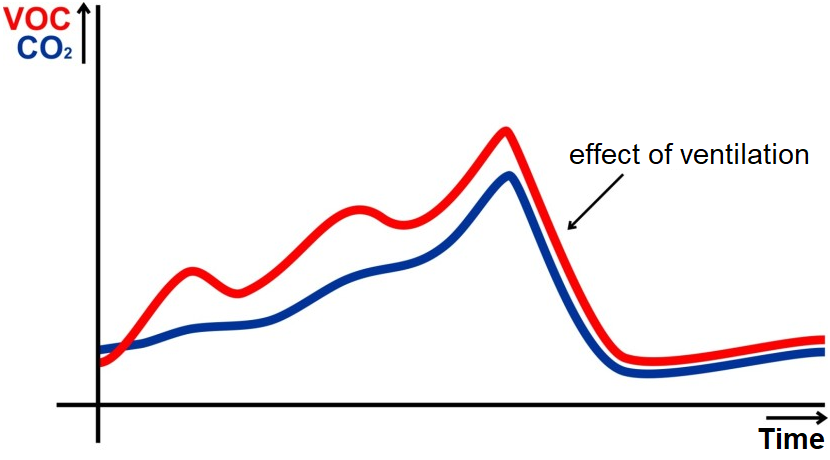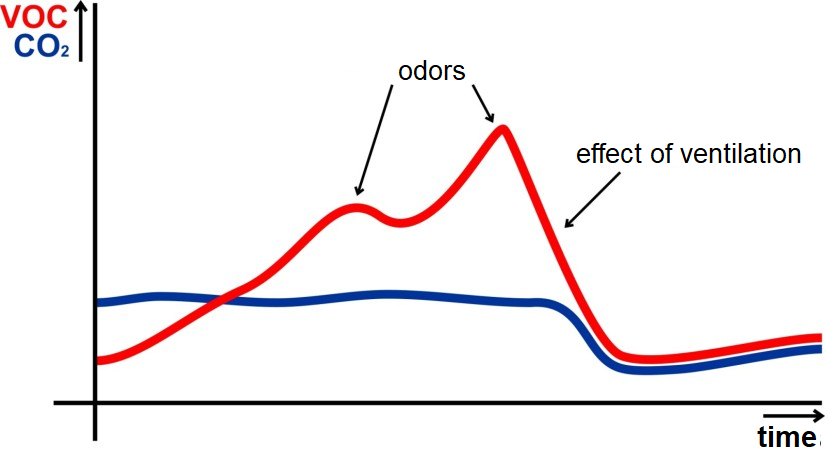4 examples of how to choose the right type of sensor for each room:
A commonly known term for an immediate assessment of the quality of indoor air from the point of view of how it is exhaled is the concentration of carbon dioxide (CO2). Today, the term is well known and close to both end customers and especially people who work in the field of ventilation and air conditioning.
ATTENTION, its measurement is not suitable everywhere.
Which sensor to choose in specific spaces?
Below are the four most common cases.
1. example: Exhaled air concentration in a room
People often move/stay in the space. Examples of such spaces can be:
- bedrooms, children's rooms
- living rooms
- offices
- conference room
- school classes
- shopping centers
- cinemas, theaters
- …
Everywhere in the above-mentioned spaces, the concentration of carbon dioxide gradually increases (among other substances) due to the breathing process of the people staying there. For such spaces, a sensor monitoring the CO2. concentration is the best choice. Thanks to the optical sensor, this is sufficiently accurate and long-term stable.
The situation there could then look roughly as shown in the graph below.

2. example: Gyms, fitness centers, locker rooms, restrooms
Another example of a space where it is necessary to first determine the predominant source of air pollution in order to choose the optimal type of sensor, are gymnasiums, fitness centers, changing rooms or toilets.
It is often a large enough space for people to breathe, or they stay there for a relatively short time. Nevertheless, it will pollute this space during its stay, thanks to a specific activity. In such a space, the concentration of CO2 can be at a relatively good level, but the air feels clearly polluted and needs to be ventilated.
In the above-mentioned spaces, another source of pollution can therefore prevail over the standard breathing process. If we were to place a CO2 sensor here, it might not show significantly high concentration values, even though pollution is clearly visible when entering such a space.
The predominant, more telling, indicator of air pollution is the so-called VOC, or Volatile Organic Compounds. The situation in such a space could then look roughly as shown in the following graph.
A suitably placed VOC sensor will perfectly solve the problem with odors and odors.

3. example: Other sources of odors and odors
The third type of space in which air quality needs to be monitored are spaces where there are other significant, predominant sources of air pollution other than those caused by the people living there. These are usually also some other materials or technological processes in the given space, such as:
- cooking and frying
- various technological processes
- fumes from furniture and carpets
- fumes from cleaning agents
- vapors from perfumes, scented candles, ...
- fumes from paints, suspended ceilings
- …
These vapors and odors are the main cause of unpleasant sensations associated with exhaled indoor air - loss of concentration, fatigue, headaches up to dizziness or even nausea and also fall into the category of VOCs.
Examples of such spaces can be:
- profesionální kuchyně, restaurace
- canteen
- newly built/renovated houses and buildings (more on that here)
- in principle, areas where people work with chemicals
- …
Here we could present the same graph as in point 2, therefore the VOC sensor is best suited here.
4. example: High humidity
Other important indicators of indoor air quality include, of course, relative humidity. This mainly applies to bathrooms, but also kitchens or laundries.
In such spaces without proper ventilation, mold can start to form relatively quickly, especially in the winter, in the corners, in the joints of the windows, and the like. Rust may appear on metal things.
Effectively controlled ventilation given by a suitably placed air humidity sensor will usually solve this problem satisfactorily
The article is prepared according to the information provided by Protronix, a Czech manufacturer of air quality sensors, further information, including the range of supplied sensors, can be found on their website cidla.cz.
 English
English